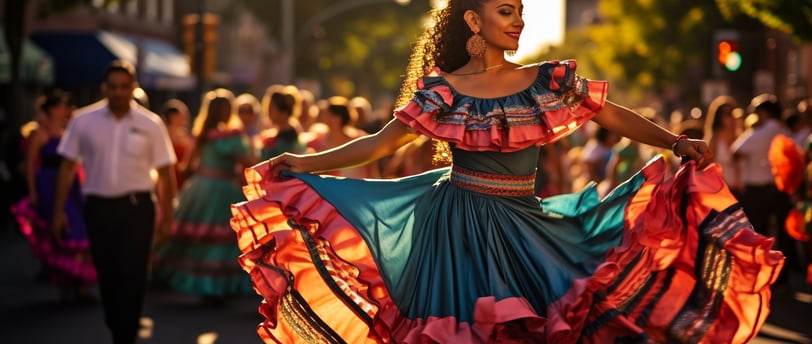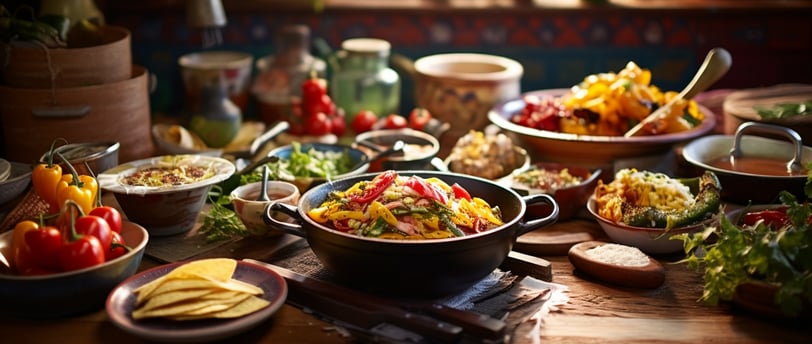Uncover Mexico's Grand Narratives: Easy Guides to Dive Deeper
Discover more of Mexico's rich history, vibrant culture, diverse cuisine, and stunning geography with our comprehensive guides, designed to reveal the heart of this extraordinary country.

Mexico is a country with a rich history and diverse culture that can captivate any traveler's imagination. From its pre-Hispanic civilizations to the Spanish conquest and struggle for independence, Mexico's past is filled with fascinating stories and grand narratives. In this article, we will take a deep dive into Mexico's history, culture, cuisine, and geography, providing easy guides to help you uncover the essence of this incredible nation.
Understanding Mexico's Rich History
Mexico's history is a tapestry woven with stories of ancient civilizations, conquest, and liberation. To truly understand Mexico, we must explore its past and the impact it continues to have on the present.
Pre-Hispanic Civilizations and Their Impact
Before the arrival of the Spanish, Mexico was home to magnificent civilizations such as the Maya, Aztec, and Zapotec. These societies flourished and left behind impressive ruins and cultural legacies that can still be seen today. From the awe-inspiring pyramids of Teotihuacan to the mystical ruins of Palenque, exploring these ancient sites is like stepping back in time.
The Spanish Conquest and Its Aftermath
The arrival of the Spanish conquistadors in the 16th century marked a turning point in Mexico's history. The conquest led to the destruction of indigenous civilizations and the introduction of European influence. The legacy of this period is evident in Mexico's language, religion, and architecture.
Mexico's Struggle for Independence
In the early 19th century, Mexico fought for its independence from Spanish rule. Heroes like Miguel Hidalgo and Benito Juarez sparked a revolution that eventually led to victory. Understanding the struggle for independence allows us to appreciate the resilience and determination of the Mexican people.
Exploring Mexico's Diverse Culture
Mexico's culture is a vibrant mosaic of traditions, beliefs, and artistic expressions. From the role of religion in Mexican society to the influence of art and literature, let's dive deeper into what makes Mexican culture so unique.
Mexico, a country rich in history and cultural diversity, is home to a fascinating blend of indigenous traditions and European influences. The fusion of these diverse elements has given rise to a vibrant and distinctive culture that captivates visitors from around the world.
The Role of Religion in Mexican Society
Religion plays a central role in Mexican society, with the majority of the population being Roman Catholic. However, what sets Mexican Catholicism apart is the unique blend of indigenous beliefs that have been seamlessly integrated into the religious practices.
The ancient indigenous civilizations of Mexico, such as the Aztecs and the Mayans, had their own complex belief systems and rituals. When the Spanish conquistadors arrived in the 16th century, they brought Catholicism with them. Over time, a fascinating syncretism occurred, resulting in a fusion of Catholicism and indigenous beliefs.
This syncretism is most evident in the celebrations and rituals that take place throughout the year. One such example is the Day of the Dead, a colorful and joyful celebration that honors deceased loved ones. During this time, families create elaborate altars adorned with marigolds, candles, and photographs of their departed relatives. It is a time of remembrance, reflection, and celebration of life.
The Influence of Art and Literature
Mexico has a long history of artistic and literary excellence, with its artists and writers making significant contributions to the global cultural landscape.
One of the most iconic figures in Mexican art is Diego Rivera, a renowned muralist whose larger-than-life paintings depict scenes of Mexican history, culture, and social issues. His murals can be found in various public spaces, such as government buildings and museums, and serve as powerful visual narratives that reflect the struggles and triumphs of the Mexican people.
In the realm of literature, Mexican authors have also left an indelible mark. Gabriel Garcia Marquez, a Colombian writer, is often associated with magical realism, a literary genre that combines fantastical elements with realistic settings and characters. Although not Mexican himself, Marquez's work has had a profound influence on Mexican literature and has inspired many Mexican authors to explore similar themes and narrative styles.
The Importance of Festivals and Celebrations
Mexicans love to celebrate, and the country is known for its lively festivals and traditions. These celebrations are not only an opportunity to have fun and enjoy good food and music, but also a way to honor the past, express cultural pride, and come together as a community.
Cinco de Mayo, often mistakenly thought of as Mexico's Independence Day, is actually a commemoration of the Mexican army's victory over the French Empire in the Battle of Puebla. It is a day when Mexicans proudly celebrate their heritage and resilience, with parades, music, and traditional dances.
Another significant celebration is the Guelaguetza, a festival that takes place in the city of Oaxaca. This colorful event showcases the rich cultural diversity of the region, with traditional dances, music, and elaborate costumes. It is a time when different indigenous communities come together to share their customs and traditions, fostering a sense of unity and pride.
These festivals and celebrations are not only a source of joy and entertainment but also a reflection of Mexico's deep-rooted cultural heritage. They serve as a reminder of the country's history, traditions, and the importance of community and togetherness.

The Evolution of Mexican Cuisine
Food is an integral part of Mexican culture, and exploring the country's culinary heritage is a delightful journey. From the indigenous ingredients and their uses to the fusion of cultures in Mexican dishes, let's savor the flavors of Mexico.
Indigenous Ingredients and Their Uses
Mexican cuisine is characterized by the use of fresh and flavorful ingredients. Corn, chili peppers, tomatoes, and cacao are just a few examples of the culinary treasures that have been passed down through generations.
The use of corn in Mexican cuisine is deeply rooted in the country's history. Corn, or maize, was domesticated in Mexico thousands of years ago and has since become a staple in Mexican dishes. It is used to make tortillas, tamales, and various other traditional foods. The process of nixtamalization, which involves soaking the corn in an alkaline solution, is used to enhance its nutritional value and make it more digestible.
Chili peppers are another essential ingredient in Mexican cuisine. They come in a variety of shapes, sizes, and heat levels, adding depth and complexity to dishes. From the mild poblano pepper used in chiles rellenos to the fiery habanero pepper found in salsas, chili peppers are a defining element of Mexican flavors.
Tomatoes, originally from the Americas, have become a fundamental ingredient in Mexican cuisine. They are used in salsas, sauces, and stews, adding a vibrant color and tangy flavor to dishes. The versatility of tomatoes allows them to be used in both traditional and modern Mexican recipes.
Cacao, the bean from which chocolate is made, has a long history in Mexico. The ancient Mayans and Aztecs considered cacao a sacred food and used it to make a bitter beverage called xocoatl. Today, cacao is still used in Mexican cuisine, particularly in mole sauces and desserts, adding a rich and complex flavor.
The Fusion of Cultures in Mexican Dishes
Mexican cuisine is a testament to the fusion of indigenous, Spanish, and other global influences. From the ancient techniques of mole preparation to the introduction of ingredients like rice and spices, each dish tells a story of cultural exchange.
The arrival of the Spanish conquistadors in the 16th century brought new ingredients and cooking techniques to Mexico. The Spanish introduced ingredients such as rice, wheat, and various spices, which were incorporated into Mexican cuisine. Rice, for example, became a staple in dishes like arroz con pollo (rice with chicken) and Mexican-style paella.
Another significant influence on Mexican cuisine came from the African slaves brought to Mexico during the colonial period. They introduced new cooking techniques and ingredients, such as plantains and various spices, which are still used in Mexican dishes today. The fusion of African, Spanish, and indigenous flavors can be seen in dishes like mole, a complex sauce made with chili peppers, spices, and chocolate.
Mexican cuisine has also been influenced by other global cultures. The introduction of Asian ingredients and cooking techniques, brought by Chinese and Filipino immigrants, has resulted in dishes like tacos al pastor, which features marinated pork cooked on a vertical spit, similar to the shawarma of the Middle East.
The Significance of Food in Mexican Traditions
Food is not just sustenance in Mexico; it is a cornerstone of traditions and celebrations. From the elaborate preparations of tamales for Christmas to the mouth-watering street tacos enjoyed on any given day, every bite transports you to the heart of Mexican culture.
Christmas in Mexico is a time of joy and celebration, and food plays a central role in the festivities. One of the most beloved traditions is the making of tamales, which are corn dough filled with various ingredients, wrapped in corn husks, and steamed. Families gather together to prepare tamales, sharing stories and laughter as they work. The process of making tamales is a labor of love, and the resulting dish is a delicious symbol of togetherness and tradition.
Street food is an integral part of Mexican culinary culture. From bustling markets to roadside stands, the aroma of sizzling meats and the sound of tortillas being freshly pressed fill the air. Tacos, in particular, are a beloved street food in Mexico. Whether filled with grilled meats, marinated seafood, or vegetarian options, tacos are a quick and flavorful meal enjoyed by people of all ages. The vibrant and diverse street food scene in Mexico reflects the country's rich culinary heritage and the creativity of its people.
Exploring the evolution of Mexican cuisine is like embarking on a journey through time and culture. From the ancient traditions of indigenous communities to the influences brought by Spanish conquistadors and other global cultures, Mexican cuisine is a vibrant tapestry of flavors and stories. So, next time you savor a plate of authentic Mexican food, take a moment to appreciate the history and heritage behind each bite.
The Geography of Mexico and Its Influence
Mexico's geography has shaped its history, climate, and way of life. Exploring the country's diverse landscapes and understanding their effects is key to unlocking the essence of Mexico.
The Variety of Landscapes and Their Effects
From the majestic mountains of the Sierra Madre to the pristine beaches of the Yucatan Peninsula, Mexico offers a breathtaking array of landscapes. These natural wonders have influenced everything from agriculture to tourism, creating a country of immense beauty and geographical diversity.
The Role of Climate in Mexican Lifestyle
Mexico's climate varies depending on its regions, ranging from the tropical heat of the coastlines to the temperate highlands. This diversity has led to the development of different ecosystems, agricultural practices, and ways of life. Understanding the climate helps us appreciate the resilience and adaptability of Mexico's people.
The Impact of Geography on Mexican History
Mexico's geographical features have shaped its history in profound ways. The abundance of natural resources, such as silver and oil, has played a crucial role in the country's development. Furthermore, Mexico's strategic location in the Americas has made it a crossroads of cultures and a melting pot of influences.
Conclusion
Mexico's grand narratives encompass a captivating history, diverse culture, mouth-watering cuisine, and awe-inspiring geography. By diving deeper into these aspects, we can truly uncover the essence of this remarkable country.
So, whether you are planning a trip to Mexico or simply curious about its wonders, embark on this journey of discovery and let Mexico's grand narratives enchant you. Uncover the hidden stories, taste the flavors, and immerse yourself in the vibrant culture of Mexico. There is no doubt that this extraordinary country will leave an indelible mark on your soul.
¡Viva México!